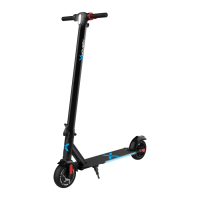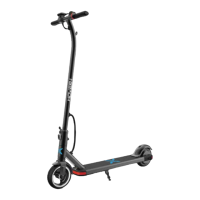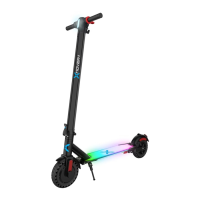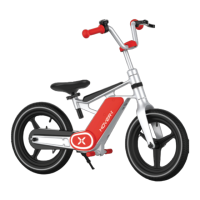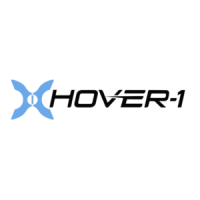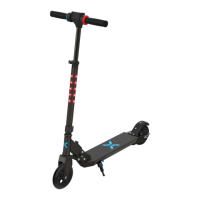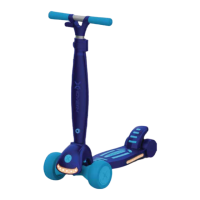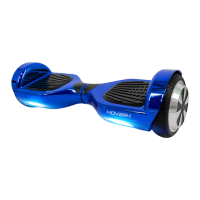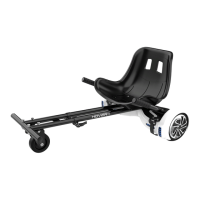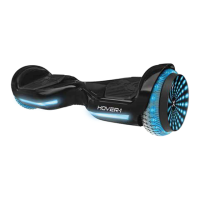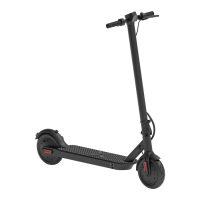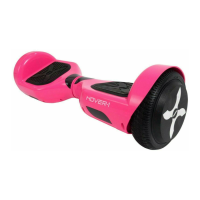Do you have a question about the Hover-1 EAGLE 3.0 and is the answer not in the manual?
Ensure helmet covers the forehead for maximum protection.
Exposed forehead increases risk of serious injury.
Indicates a hazard that can cause serious injury or death if not avoided.
Indicates a hazard that can cause minor or moderate injury if not avoided.
Read manual, learn to ride safely, users are responsible for consequences.
Specifies safe operating temperature range for charger and scooter.
Cold temperatures affect lubrication, increasing resistance and decreasing battery capacity.
Keep away from heat, water, liquids; avoid damage, punctures, dust, and misuse.
Advice for individuals with medical conditions, pregnancy, or heart issues.
Keep serial number for warranty claims and proof of purchase.
Details about the Eagle 3.0 E-Scooter and the importance of the manual.
Emphasizes common sense, local laws, and wearing a helmet.
Obey traffic laws, ride defensively, yield to pedestrians, and alert them.
Use headlights and bright clothing in low visibility, and be aware of visibility limitations.
Maintain distance, keep feet on scooter, avoid substances, and use judgment.
Avoid curbs, ramps, rough terrain, and water; bend knees on bumps.
Apply brakes gradually for safe stopping, avoid sudden force.
Do not ride over bumps, in crowds, distracted, where not permitted, or with pets.
Avoid potholes, cracks, off-road; respect maximum weight limit.
Avoid flammable areas, bodies of water, and inclement weather like snow or rain.
Avoid liquids, solvents, extreme temperatures, sharp objects, and falls to protect the device.
Do not dispose in fire, do not disassemble; use only Hover-1 charger and authorized parts.
Details on battery type, charge time, voltage, capacity, and operating/storage conditions.
Do not disassemble, use provided charger, avoid fire/sunlight, do not overcharge, recycle properly.
Do not modify, use if leaking/overheating; keep away from children/animals; seek medical help if exposed.
Model, weight, speed, range, battery, power, dimensions, tires, brakes, certification.
Lists and illustrates the main components included with the E-Scooter.
Labeled diagram showing 14 features and parts of the scooter.
Explains speedometer, speed modes, headlight, cruise control, battery indicators, and power button functions.
Instructions for connecting and charging the scooter, indicator light meanings.
Guide on how to properly attach handlebars and adjust related assemblies.
Highlights areas where hands can be pinched during folding/unfolding processes.
Step-by-step guide for folding and unfolding the steering column.
Explains speed modes (P1/P2) and the requirement to kick start for acceleration.
Details on how to activate and cancel the cruise control feature.
Essential checks for safe operation, including area suitability and system functionality.
Ensures battery is charged and appropriate safety gear and clothing are worn.
Instructions for powering on, activating the motor, steering, and using brakes.
Guidance on shifting weight for stability and bracing for uneven surfaces.
Specifies maximum speed and supported weight limits for safe operation.
Lists factors like terrain, rider weight, ambient temperature, and riding style.
Common system alerts for errors, low battery, overheating, and blocked tires.
FCC statement regarding device compliance and potential interference.
List of error codes and their likely causes and required actions for troubleshooting.
Ensure helmet covers the forehead for maximum protection.
Exposed forehead increases risk of serious injury.
Indicates a hazard that can cause serious injury or death if not avoided.
Indicates a hazard that can cause minor or moderate injury if not avoided.
Read manual, learn to ride safely, users are responsible for consequences.
Specifies safe operating temperature range for charger and scooter.
Cold temperatures affect lubrication, increasing resistance and decreasing battery capacity.
Keep away from heat, water, liquids; avoid damage, punctures, dust, and misuse.
Advice for individuals with medical conditions, pregnancy, or heart issues.
Keep serial number for warranty claims and proof of purchase.
Details about the Eagle 3.0 E-Scooter and the importance of the manual.
Emphasizes common sense, local laws, and wearing a helmet.
Obey traffic laws, ride defensively, yield to pedestrians, and alert them.
Use headlights and bright clothing in low visibility, and be aware of visibility limitations.
Maintain distance, keep feet on scooter, avoid substances, and use judgment.
Avoid curbs, ramps, rough terrain, and water; bend knees on bumps.
Apply brakes gradually for safe stopping, avoid sudden force.
Do not ride over bumps, in crowds, distracted, where not permitted, or with pets.
Avoid potholes, cracks, off-road; respect maximum weight limit.
Avoid flammable areas, bodies of water, and inclement weather like snow or rain.
Avoid liquids, solvents, extreme temperatures, sharp objects, and falls to protect the device.
Do not dispose in fire, do not disassemble; use only Hover-1 charger and authorized parts.
Details on battery type, charge time, voltage, capacity, and operating/storage conditions.
Do not disassemble, use provided charger, avoid fire/sunlight, do not overcharge, recycle properly.
Do not modify, use if leaking/overheating; keep away from children/animals; seek medical help if exposed.
Model, weight, speed, range, battery, power, dimensions, tires, brakes, certification.
Lists and illustrates the main components included with the E-Scooter.
Labeled diagram showing 14 features and parts of the scooter.
Explains speedometer, speed modes, headlight, cruise control, battery indicators, and power button functions.
Instructions for connecting and charging the scooter, indicator light meanings.
Guide on how to properly attach handlebars and adjust related assemblies.
Highlights areas where hands can be pinched during folding/unfolding processes.
Step-by-step guide for folding and unfolding the steering column.
Explains speed modes (P1/P2) and the requirement to kick start for acceleration.
Details on how to activate and cancel the cruise control feature.
Essential checks for safe operation, including area suitability and system functionality.
Ensures battery is charged and appropriate safety gear and clothing are worn.
Instructions for powering on, activating the motor, steering, and using brakes.
Guidance on shifting weight for stability and bracing for uneven surfaces.
Specifies maximum speed and supported weight limits for safe operation.
Lists factors like terrain, rider weight, ambient temperature, and riding style.
Common system alerts for errors, low battery, overheating, and blocked tires.
FCC statement regarding device compliance and potential interference.
List of error codes and their likely causes and required actions for troubleshooting.
